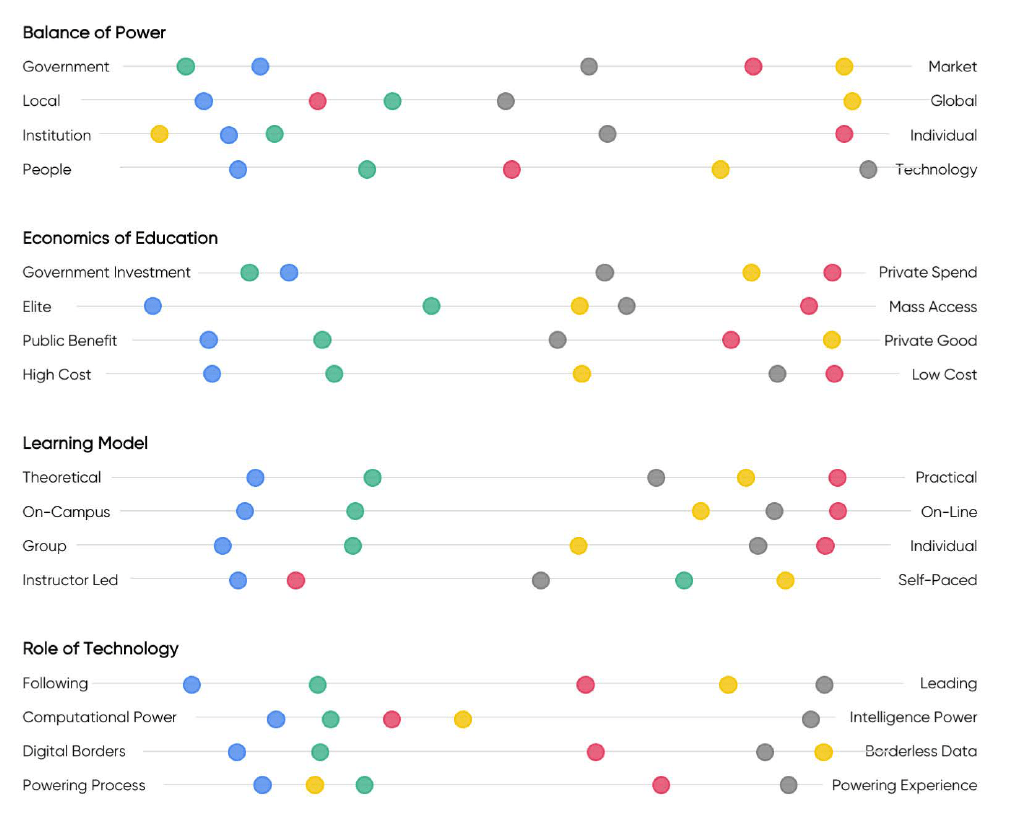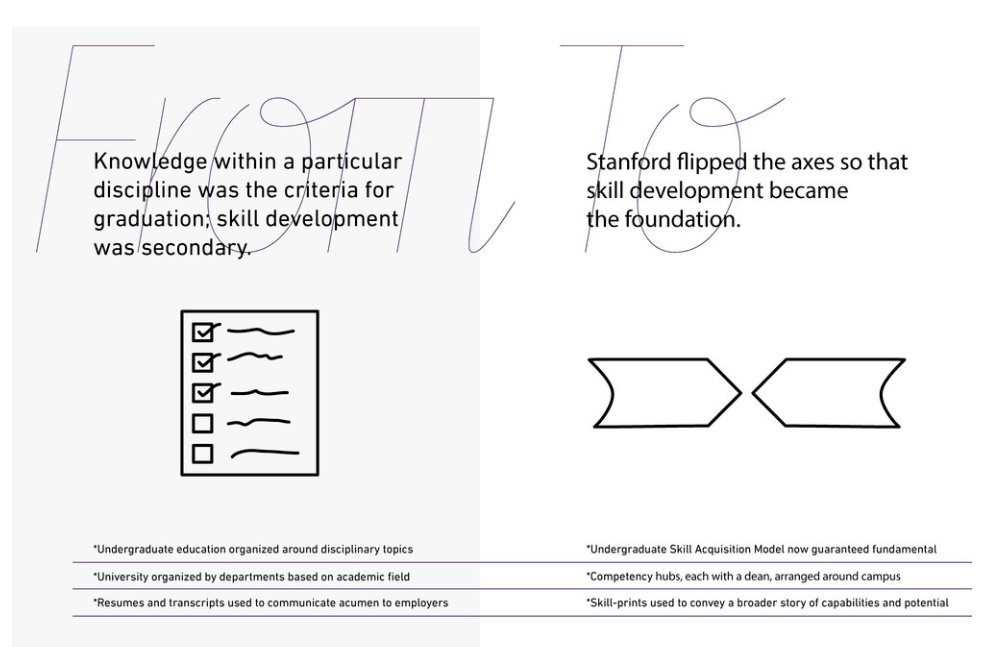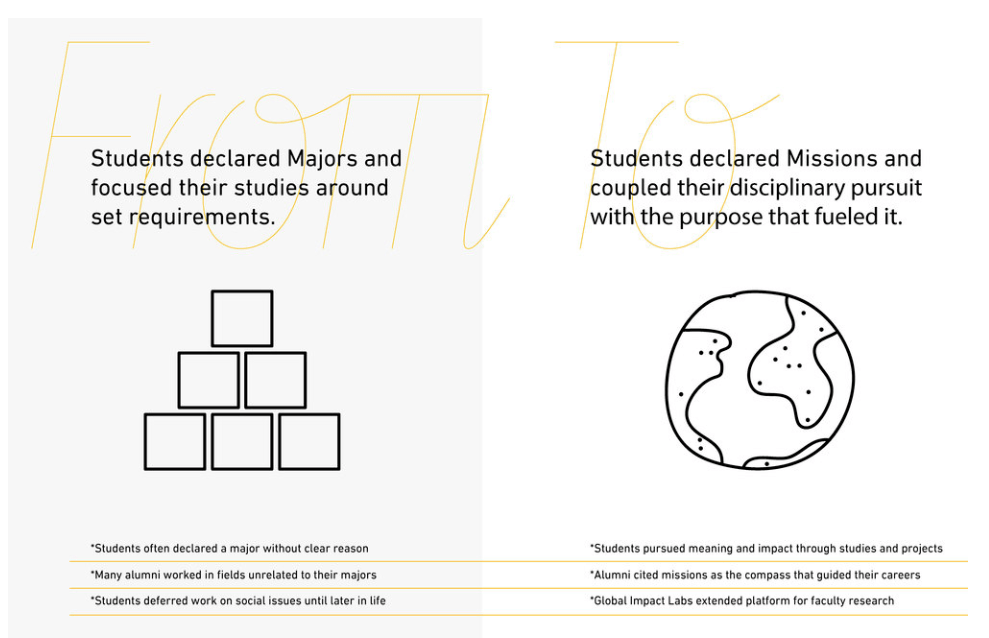Stephen Downes noted this report in his blog post a few days back, noting:
“This report has some flaws but it is overall a far better snapshot of the future of learning than many of its contemporaries… five scenarios dominate – education as usual, global giants, regional rising, peer-to-peed, and robo revolution. These aren’t depicted as alternatives per se – they’re all at play in our complex environment, influenced by (and influencing) governments, markets, research, etc., each to a different degree. I like this report a lot, and my brain feels a lot like the graph diagrammed here.”
Indeed!
The entire report is worth downloading. The snapshot in the front shows the five scenarios, and I found the sliding scales for balance of power, economics of education globally, learning models, and role of technology fascinating.
Note how education as usual (blue) plots on the left side while global giants (yellow), peer-to-peer (pink) and robo revolution (grey) plot opposite…which is an interesting suggestion! The green is the regional alliances they see rising. Drilling in to specific scales such as the role of technology and whether one is following or leading, education plotted left for following, while global giants and robo revolution plotted as leaders. For those in positions of leadership in education, is “following” the route we should be taking?
HolonIQ used a dual approach to develop this report, first using machine learning to cull 5,000 news articles worldwide to develop clusters, and then consulted experts to develop their five scenarios. They forecast that education will be a $10 Trillion industry globally by 2030. Note that these five scenarios are not mutually exclusive…each will be in play in different ways.
For instance, traditional education will remain a trusted source of learning. But they note that the re-skilling needed for the emerging workplace will suggest closure of some niche colleges and the opening of new breeds of post-secondary vocational providers. For a global workforce, new forms of authentication and certification will emerge.
The report suggested that by 2030, the “gig economy” will be in full swing, such that a degree might be less helpful than a peer recommendation. The report suggested that:
The contingent workforce also needs to constantly upskill and the skyrocketing demand for effective, flexible, just-in-time, personalized and ongoing skills training is filled by a global peer-to-peer learning market, much of which is serviced by contingent faculty…
As such, measuring “learning” – as distinct from “education” – could be a lucrative market for the future.
For me, one of the more interesting slides in this report was on the top skills, abilities, and knowledge for the coming decade:
- Judgement and Decision Making
- Fluency of Ideas
- Active Learning
- Learning Strategies
- Originality
- Systems and Evaluation
- Deductive Reasoning
- Complex Problem Solving
- Systems Analysis
- Monitoring
- Critical Thinking
- Instructing
- Education and Training
- Management of Personnel Resources
- Coordination
- Inductive Reasoning
- Problem Sensitivity
- Information Ordering
- Active Listening
- Administration and Management
Note that “leadership” is not listed … which I find both interesting and troubling. I also find it interesting that active learning came in at #3, but active listening is at #19. I am guessing the #12 instructing is peer instructing, since it is separate from #13 education and training.
This list is quite different from the Work Skills 2020 list I share with my classes from the Institute for the Future.
Yet, both lists seem to focus in on the things that differentiate us from machines…what Joseph Aoun suggested make us “Robot-Proof.”
The report noted that automation was a double threat to education, not only automating some education services, but also training people for jobs that are disappearing. The report also highlighted the Stanford 2025 model of higher education that I have linked to in the past.
The report suggested that another billion learners will join the world in the next decade, so these new models of learning will be necessary to meet this need.
As I said, lots to chew on in this report. One may not agree with all the conclusions and recommendations, but whether one sees education continuing as usual or being overtaken by AI (and the answer may be “both and neither”), this report is thought provoking. I would be interested in your reactions.
(…and apologies to Dr. Suess for my post title!)
{Graphics: HolonIQ, IFTF, Stanford2025}









Great post – interesting that the From/To graphic was really pushing a 6-year-over-the-course-of-your-lifetime model of higher education. Perhaps, but one trend (at least, in Ohio) seems to be the rapid expansion of post-secondary options while students are in high school, which would have the impact of reducing time spent at the next level. For example, see the College Credit Plus program (https://www.ohiohighered.org/content/college_credit_plus_about). Then again, this is still based on the four-year traditional progression, so perhaps the 6-year model will come about as a result of revolutionary change.